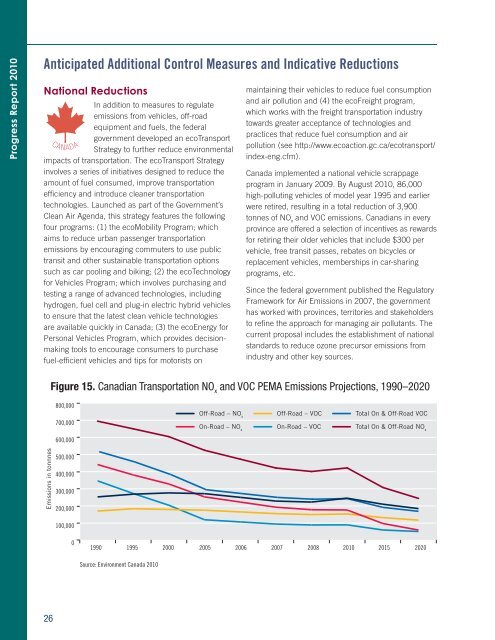2010 Progress Report - International Joint Commission
2010 Progress Report - International Joint Commission
2010 Progress Report - International Joint Commission
You also want an ePaper? Increase the reach of your titles
YUMPU automatically turns print PDFs into web optimized ePapers that Google loves.
<strong>Progress</strong> <strong>Report</strong> <strong>2010</strong><br />
Anticipated Additional Control Measures and Indicative Reductions<br />
National Reductions<br />
In addition to measures to regulate<br />
emissions from vehicles, off-road<br />
equipment and fuels, the federal<br />
government developed an ecoTransport<br />
Strategy to further reduce environmental<br />
impacts of transportation. The ecoTransport Strategy<br />
involves a series of initiatives designed to reduce the<br />
amount of fuel consumed, improve transportation<br />
effi ciency and introduce cleaner transportation<br />
technologies. Launched as part of the Government’s<br />
Clean Air Agenda, this strategy features the following<br />
four programs: (1) the ecoMobility Program; which<br />
aims to reduce urban passenger transportation<br />
emissions by encouraging commuters to use public<br />
transit and other sustainable transportation options<br />
such as car pooling and biking; (2) the ecoTechnology<br />
for Vehicles Program; which involves purchasing and<br />
testing a range of advanced technologies, including<br />
hydrogen, fuel cell and plug-in electric hybrid vehicles<br />
to ensure that the latest clean vehicle technologies<br />
are available quickly in Canada; (3) the ecoEnergy for<br />
Personal Vehicles Program, which provides decisionmaking<br />
tools to encourage consumers to purchase<br />
fuel-effi cient vehicles and tips for motorists on<br />
CANADA<br />
maintaining their vehicles to reduce fuel consumption<br />
and air pollution and (4) the ecoFreight program,<br />
which works with the freight transportation industry<br />
towards greater acceptance of technologies and<br />
practices that reduce fuel consumption and air<br />
pollution (see http://www.ecoaction.gc.ca/ecotransport/<br />
index-eng.cfm).<br />
Canada implemented a national vehicle scrappage<br />
program in January 2009. By August <strong>2010</strong>, 86,000<br />
high-polluting vehicles of model year 1995 and earlier<br />
were retired, resulting in a total reduction of 3,900<br />
tonnes of NO x<br />
and VOC emissions. Canadians in every<br />
province are offered a selection of incentives as rewards<br />
for retiring their older vehicles that include $300 per<br />
vehicle, free transit passes, rebates on bicycles or<br />
replacement vehicles, memberships in car-sharing<br />
programs, etc.<br />
Since the federal government published the Regulatory<br />
Framework for Air Emissions in 2007, the government<br />
has worked with provinces, territories and stakeholders<br />
to refi ne the approach for managing air pollutants. The<br />
current proposal includes the establishment of national<br />
standards to reduce ozone precursor emissions from<br />
industry and other key sources.<br />
Figure 15. Canadian Transportation NO x<br />
and VOC PEMA Emissions Projections, 1990–2020<br />
800,000<br />
700,000<br />
Off-Road – NO x<br />
On-Road – NO x<br />
Off-Road – VOC<br />
On-Road – VOC<br />
Total On & Off-Road VOC<br />
Total On & Off-Road NO x<br />
600,000<br />
Emissions in tonnnes<br />
500,000<br />
400,000<br />
300,000<br />
200,000<br />
100,000<br />
0<br />
1990 1995 2000 2005 2006 2007 2008 <strong>2010</strong> 2015<br />
Source: Environment Canada <strong>2010</strong><br />
2020<br />
26
















